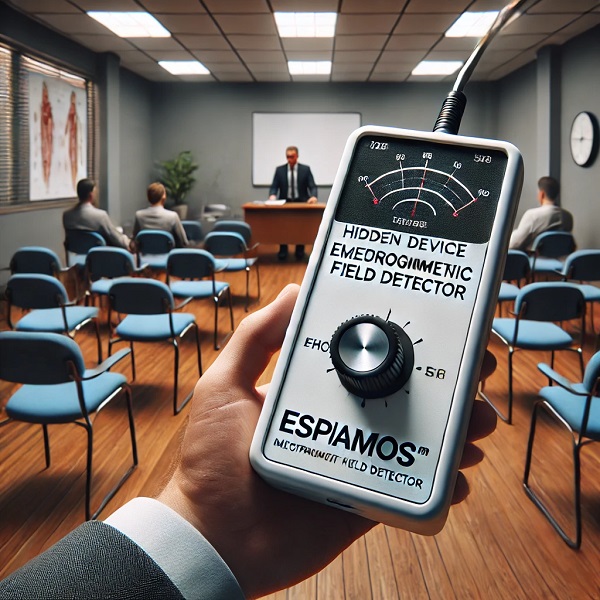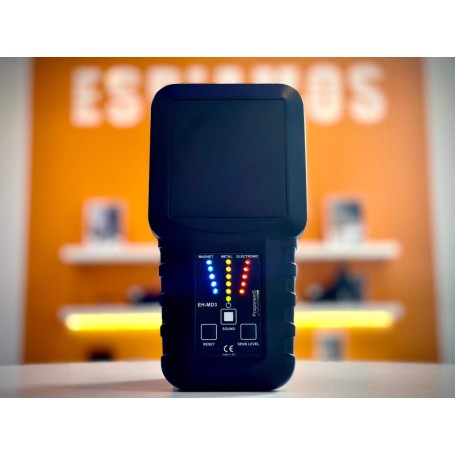Electromagnetic field detectors have become essential tools for uncovering hidden devices such as choke collars used in exam cheating. These devices, which create an electromagnetic field to transmit information to earpieces, are increasingly difficult to detect with the naked eye, making detection technology critical in the fight against academic fraud.

Table of Contents
- What are electromagnetic field detectors?
- How do electromagnetic field detectors work?
- Utility of detectors in identifying inductive collars
- Advantages of using electromagnetic field detectors in examinations
- Conclusion
- FAQ: Frequently Asked Questions
What are electromagnetic field detectors?
Electromagnetic field detectors are devices designed to measure and detect alterations in electromagnetic fields generated by electronic devices. These devices can identify the presence of any device that is generating a field, whether it is a hidden camera, a microphone, or an inductive collar.
Induction collars are frequently used in exam cheating, allowing communication with an earpiece without being obvious. Electromagnetic field detectors make it possible to locate the source of these fields, making it easier to identify hidden devices and helping to prevent academic fraud.
How do electromagnetic field detectors work?
To understand the effectiveness of these detectors, it is crucial to understand how they work. An EMF detector works by measuring the intensity of the field surrounding any operating electronic device. All electronic devices generate some level of electromagnetic field when they are turned on, making them easy to detect.
When a student wears a neckloop during an exam, the device creates a field around the body as it transmits signals to the earpiece inside the user's ear. The detector is able to pick up this signal and sound an alarm when it detects an unusual change in the electromagnetic field.

Utility of detectors in identifying inductive collars
Induction collars are one of the most commonly used devices for cheating on exams, as they allow almost undetectable communication between the user and an external accomplice. However, although they are difficult to see, they generate an electromagnetic field that can be picked up by specialized detectors.
Using these detectors allows not only to locate the induction collar in operation, but also to monitor the entire environment for other signals, such as those emitted by devices connected via Bluetooth or any other wireless technology. This makes electromagnetic field detectors an integral tool for monitoring during examinations.
Advantages of using electromagnetic field detectors in examinations
The use of electromagnetic field detectors in the educational context offers numerous advantages:
- Effectiveness: These detectors are extremely accurate, allowing hidden devices to be identified in real time.
- Non-invasive: Unlike a physical inspection, detectors do not require contact with students, ensuring their privacy is respected.
- Deterrent: The presence of these devices deters students from trying to cheat, knowing that advanced technology is monitoring their exams.
In the next part of the article, we will further explore the applications of these detectors in different contexts and how they are combined with other detection equipment to offer a comprehensive solution in the fight against academic fraud.
Applications of electromagnetic field detectors in examinations
Electromagnetic field detectors are primarily used in situations where the use of technological devices for cheating on exams is suspected. Below, we explore some of the most common applications of these devices in the educational field and how they can help prevent academic fraud.
Detection of induction collars
Cheating collars are one of the most commonly used tools by students to covertly cheat. By generating an electromagnetic field to transmit signals to the earpieces, these collars allow discreet communication with an accomplice outside the exam room. Thanks to electromagnetic field detectors , supervisors can quickly identify the presence of these collars, even if they are hidden under the student's clothing.
These detectors are able to detect variations in the electromagnetic fields generated by the collars when they are active, making it easier to locate them without the need for physical inspections. At the same time, they can constantly monitor the environment, ensuring that any suspicious devices are identified before they cause problems.
Detection of earpieces and Bluetooth devices
Bluetooth earpieces are another popular method used in exam cheating, as they allow wireless communication between the student and an outside accomplice. These devices operate via Bluetooth technology, meaning they also generate an electromagnetic field detectable by electromagnetic field detectors . This way, any signal emitted by the earpiece can be picked up and the device quickly located.
In addition to earpieces, other Bluetooth-connected devices such as mobile phones or headsets can be detected using this technology. In this way, exam supervisors can ensure that no unauthorised devices are used for cheating.
Detecting other hidden electronic devices
Electromagnetic field detectors are not only useful for locating choke collars or nano-earpieces , but also for identifying any type of hidden electronic device that is generating a field. This includes spy cameras, hidden mobile phones and GPS trackers, which are often used for unethical purposes during important examinations.
Any device that is in operation will emit some form of electromagnetic field, making it easy to identify using this technology. The detectors are able to constantly monitor the environment, and can alert supervisors if they detect unwanted signals. This allows for full control of the exam room without the need to interrupt the test or perform invasive physical inspections.
Detector Combination: A Comprehensive Approach
To ensure maximum effectiveness in detecting hidden devices during exams, it is advisable to use a combination of electromagnetic field detectors along with other types of detectors, such as metal detectors and frequency detectors . This combination provides a comprehensive approach to identifying any attempts at cheating.
The complement of metal detectors
Metal detectors They are particularly useful for identifying devices that contain metal components, such as earpieces or hidden cameras. Although not all sensor collars contain metal parts, the combination of a metal detector and an electromagnetic field detector ensures that any suspicious device can be located, whether electronic or metallic.
Metal detectors are a common tool in examinations, allowing for the rapid identification of devices that may be hidden in students' clothing or belongings. Used in conjunction with electromagnetic field detectors, they offer a complete, non-invasive solution to ensure the integrity of examinations.
The importance of frequency detectors
Frequency detectors play a key role in detecting devices that use wireless technology, such as inductive collars and Bluetooth earpieces. These detectors are able to identify the signals emitted by these devices, allowing supervisors to accurately locate the source of the signal and prevent any attempt at fraud.
By combining frequency detectors with electromagnetic field detectors and metal detectors, it is possible to cover all angles and ensure that no unauthorized device goes undetected. This offers comprehensive protection against any type of technology used to cheat on exams.
Conclusions on the use of electromagnetic field detectors in examinations
Electromagnetic field detectors have become a key tool for ensuring fairness in exams and preventing the use of unauthorized devices. By detecting fields generated by choke collars, earpieces, and other hidden electronic devices, these detectors offer an efficient and non-invasive solution to ensure the integrity of educational processes.
Additionally, when combined with frequency detectors and metal detectors , proctors can ensure complete detection of any technology used for cheating. This combination of technologies ensures that educational institutions have all the tools necessary to identify potential violations without disrupting exams or compromising student privacy.
In an increasingly technology-dependent environment, it is critical for institutions to adopt modern and effective solutions to prevent academic fraud. Electromagnetic field detectors, along with other types of detectors, help maintain a fair and secure exam environment, providing peace of mind for both students and exam administrators.
Frequently Asked Questions (FAQ) about electromagnetic field detectors in examinations
What devices can electromagnetic field detectors detect?
Electromagnetic field detectors can identify any device that generates an electromagnetic field, such as choke collars, Bluetooth earpieces , spy cameras, and other electronic devices. Their ability to detect signals from these devices makes them ideal for use in examinations where the presence of unauthorized technology is suspected.
How do electromagnetic field detectors work in combination with other detectors?
When combined with frequency detectors and metal detectors , electromagnetic field detectors offer complete coverage against technological cheating in examinations. While frequency detectors pick up signals from wireless devices and metal detectors locate metal components, electromagnetic field detectors identify any fields generated by hidden devices.
Is it legal to use electromagnetic field detectors during exams?
In most countries, it is legal to use electromagnetic field detectors in exams, provided that educational institutions inform students about their use. This ensures a fair testing environment and avoids potential legal disputes related to privacy.
Can students disable devices detected by electromagnetic field detectors?
In general, devices that generate electromagnetic fields cannot be disabled without turning them off completely. Even if a student tries to hide a device, the generated field will still be present, making it easier to detect using electromagnetic field detectors .
How effective is the detection of induction collars with electromagnetic field detectors?
Induction collars generate a constant electromagnetic field while in operation, making them highly detectable by electromagnetic field detectors . These detectors are one of the most effective tools for identifying such devices during examinations.
What kind of training does staff need to use electromagnetic field detectors?
Although EMF detectors are easy to use, it is recommended that examination staff receive specific training to understand how these devices work and how to correctly interpret the alerts. This will ensure that they can use them effectively and accurately during examinations.






 WhatsApp
WhatsApp Telegram
Telegram


